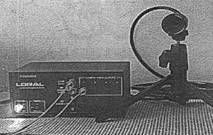
Loral Fairchild CAM5000 / CAM5002 & 4MEG VIDEO Turn Night Into Day with Extended Integration

The Loral Fairchild CAM5000 / CAM5002 is an RS-170 compatible camera with a unique controller setup, three non-standard video formats, element anti-blooming (in the CAM5002 version), and with support for multiple sensors.
Physical Description
The camera's configuration is unique, consisting
of up to four sensor heads, each with a 12 foot cable, connected
to a single controller. Using a single controller makes multi-sensor
image capture more economical, and provides precise image synchronization.
The controller can be driven with an external pixel clock. This feature provides synchronization with the 4MEG VIDEO, or can be used to run the camera at higher frequencies than the controller's 7.16 MHz internal data rate. The 4MEG VIDEO Model 12 can drive the controller at rates up to the controller's maximum frequency of 28 MHz, providing 60 interlaced frames per second (fps), or 120 fields per second!
Video Formats
The CAM5000/ CAM5002 provides RS-170 interlaced output
at 30 fps, non-interlaced and pseudo-interlaced output at 60 fps,
and an extendable exposure mode (with programmable integration).
RS-170
In standard RS-170 mode the camera supplies 30 fps
with a resolution of 378x483 pixels.
Non-Interlaced
The non-interlaced format provides 50% of the vertical
resolution (240 lines) but at 60 fps. This 378x240 format is better
suited for capturing fast moving objects, or when many frames
need to be stored in limited memory space.
Pseudo-Interlaced
Similar to the non-interlaced format, the pseudo-interlaced
format provides 1/60 second exposure times, and provides true
vertical resolution of 240 lines, but with the optical effect
of 360 lines on a standard monitor. This improvement in perceived
vertical resolution is accomplished by the addition of sensor
lines 1 and 2, 3 and 4, etc., in the vertical shift register at
the start of odd fields, and by the addition of lines 2 and 3,
4 and 5, etc., at the start of even fields.
As the eye views two consecutive pseudo-interlaced fields, the shifted images produce an apparent vertical resolution of 360 lines. Pseudo-interlacing provides the fast frame rates of non-interlaced capture (60 frames per second) while providing better [perceived] vertical resolution that is 75% of standard RS-170 interlaced display.
CAM5002 & Anti-Blooming
In all modes, the CAM5002, with the anti-blooming feature, limits the charge that can be accumulated in an array element to the maximum that can be removed in one clock cycle. This capability prevents excess charge from spilling over into adjacent pixels, and reduces the characteristic expansion of bright spots along horizontal and vertical lines in an image referred to as "blooming."
|
By The Light Of The VGA ...
| |
|
Figures 1 and 2 are images taken by the camera of
itself (with the aid of a mirror) with a VGA monitor as the only
source of illumination. Both images were taken with the camera's
lens aperture set at an f-stop of 2.8.
| |
| Figure 1: Integrated for 1/30 second using RS-l 70 timing. Only the control unit's LED is visible. | 
|
| Figure 2: Integrating for 10 seconds yields a properly exposed image, in the same lighting conditions as Figure 1. | 
|
| Figure 3: Figure 2 normalized with 4MIP software by subtracting a background (dark current) image obtained by integrating 10 seconds with the camera's lens covered. | 
|
4MEG VIDEO Model 12
The Model 12 provides full support of the CAM5000
/ CAM5002 in all of its various modes of operation, including
use of multiple sensor heads. Driving the camera with the Model
12's pixel clock provides user control of frame rates in non-RS-170
modes.
Of particular note is the Model 12's control of extended integration. Integration is triggered by the external output signal from the Model 12, and can be controlled using the Triggered Image Capture menu of 4MIP. 4MIP allows the camera to integrate for any user-defined number of field times to produce a single frame.
Dark Current Considerations
The dark current from the sensor is very low, so
long integrations are possible. Also, the pixel dark signal pattern
is a spatially constant function dependent only on integration
time. Therefore, the dark signal pattern is repeatable. Only at
integration times greater than 2 minutes does the dark current
effectively saturate the image. Using this "shutter,"
images can be obtained in low-light environments with little noise.
For further information on Loral Fairchild cameras contact:
EPIX Vision - January 1994 Newsletter
Specifications and prices subject to change without notice.
EPIX® imaging products are made in the USA.
Copyright © 2025 EPIX, Inc. All rights reserved.